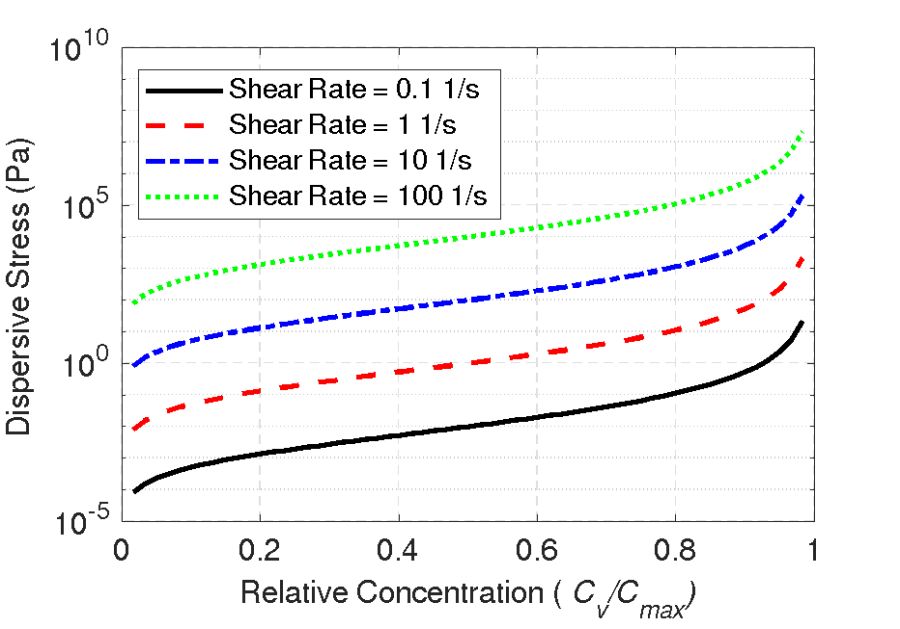Download PDF
Download page Rheological Models.
Rheological Models
Rheology is the study of mechanical properties and flow of matter, specifically non-Newtonian fluids, mixtures, and plastic solids.
Bingham
The Bingham (Bingham 1922) model is one of the simplest of the rheological models. It Bingham stress is the sum of the yield and viscous stresses
| \tau_{MD} = \tau_y + \tau_v |
| \tau_v = \mu_m \dot{ \gamma } |
where \tau_y is the yield stress, \tau_v is the viscous stress, \mu_m is the mixture dynamic viscosity, and \dot{ \gamma } is the shear rate. This model has a linear stress-strain relationship, with a non-zero intercept. Therefore, \tau_yand \tau_v represent the intercept and the slope respectively of the stress-strain relationship. For stresses less than the yield stress the fluid behaves as a solid. The Bingham model is useful for simulating mudflows under low shear rates in which the yield and viscous stresses depend on the cohesion of fine sediments (Govier and Aziz, 1982; Julien 1995; Julien and Leon, 2000). However, the Bingham model has also been a practical model for use in simulating debris flows (Huang and Dai, 2014; Dai et al., 20)
Quadratic
The so called Quadratic model was proposed by O'Brien and Julien (1985) and combines stresses due to: (1) cohesion, (2) internal friction between sediment and fluid, (3) turbulence, and (4) inertial impact between particles. The quadratic model may be written as
| \tau_{MD} = \tau_y + \tau_v + \tau_d \vspace{1} \tau_v = \mu_m \dot \gamma \vspace{1} \tau_d = c_{Bd} \rho_s \lambda^2 d^2_s \dot\gamma^2 |
where \tau_d is the dispersive stress, c_{Bd} is an empirical coefficient, \rho_s is the sediment particle density, d_s is a representative particle diameter, and \lambda is the linear sediment concentration. The dispersive stress was originally proposed by Bagnold (1954). Bagnold (1954)and Takahashi (1980) proposed c_{Bd} = 0.01. The linear sediment concentration \lambda is defined by (Bagnold 1954)
| \frac{1}{\lambda} = \left ( \frac{C_{max}}{C_v} \right )^{1/3} - 1 |
in which C_vis the sediment concentration by volume and C_{max}is the maximum sediment concentration. An example of the dispersive stress as a function of concentration and shear rate is shown in the figure below. The formulation shows a sharp increase as the concentration approaches the maximum concentration. 
Herschel-Bulkley
In the Bingham rheological resistance model, the relationship between shear rate and shear stress is linear. However experiment have shown that debris-flow mixtures can have non-linear relationships (Major and Pierson 1992; Jeffrey et al. 2001). A more general model which allows for this nonlinearity is the Herschel-Bulkley (HB) model:
| \tau_{MD} = \tau_y + \tau_{vd} \vspace{1} \tau_{vd} = K \dot {\gamma} ^n |
where K is the consistency factor or index, and n is the power index or exponent. When n < 1 the fluid/mixture is shear-thinning and when n > 1 the fluid/mixture is shear thickening. The as with other rheological models, when the stress is less than the yield stress, the fluid/mixture behaves as a solid. One issue with the HB model is that the consistency factor as dimensional units which are a function of the power index. This makes estimating the parameter somewhat difficult. The HB model has been shown to work well for suspensions of fine sediments under high shear rates (Govier and Aziz, 1982).
Voellmy
The Voellmy resistance model combines a yield stress with a viscous/turbulent stress as (Voellmy 1955)
| \tau_{MD} = \tau_y + \tau_{vd} \vspace{1} \tau_{vd} = \frac{ \rho_m g |\boldsymbol{V}|^2 } {\xi} |
where \xi is the Voellmy turbulence coefficient. Voellmy original proposed the formulation to simulate snow avalanches but it has since also been applied to simulate mud slides, debris flows, and rock avalanches (e.g. Hergarten and Robl, 2015; Hungr and Mcdougall, 2009; Körner, 1976; Perla et al., 1980; Rickenmann and Koch, 1997; Hussin et al., 2012). The Voellmy coefficient \xi is similar to a Chezy coefficient and has units of L/T2. Common ranges for the coefficient are from 150 to 600 m/s2. In the Voellmy model, the yield stress is typically computed with the Mohr-Coulomb yield stress with the cohesion set to zero.